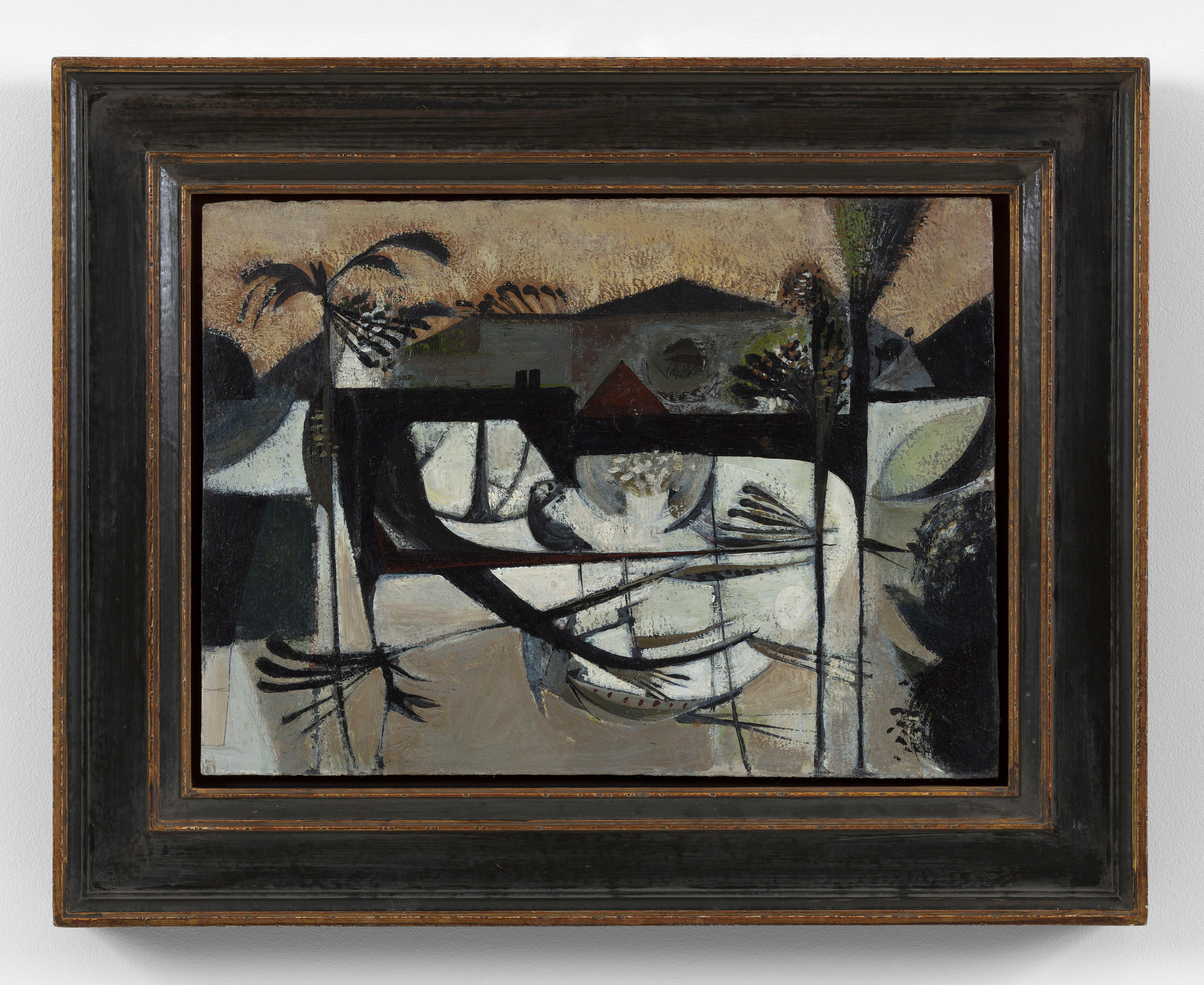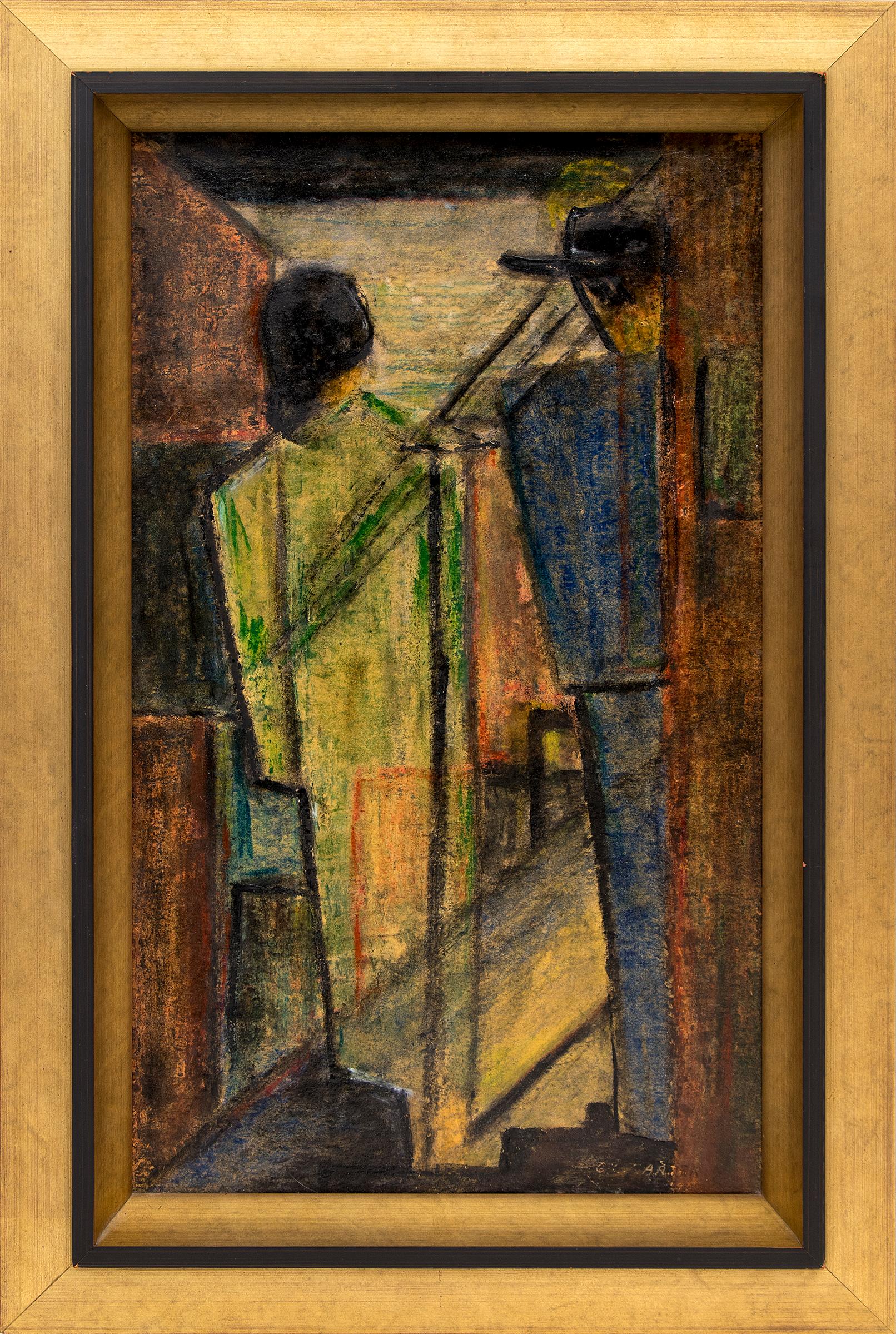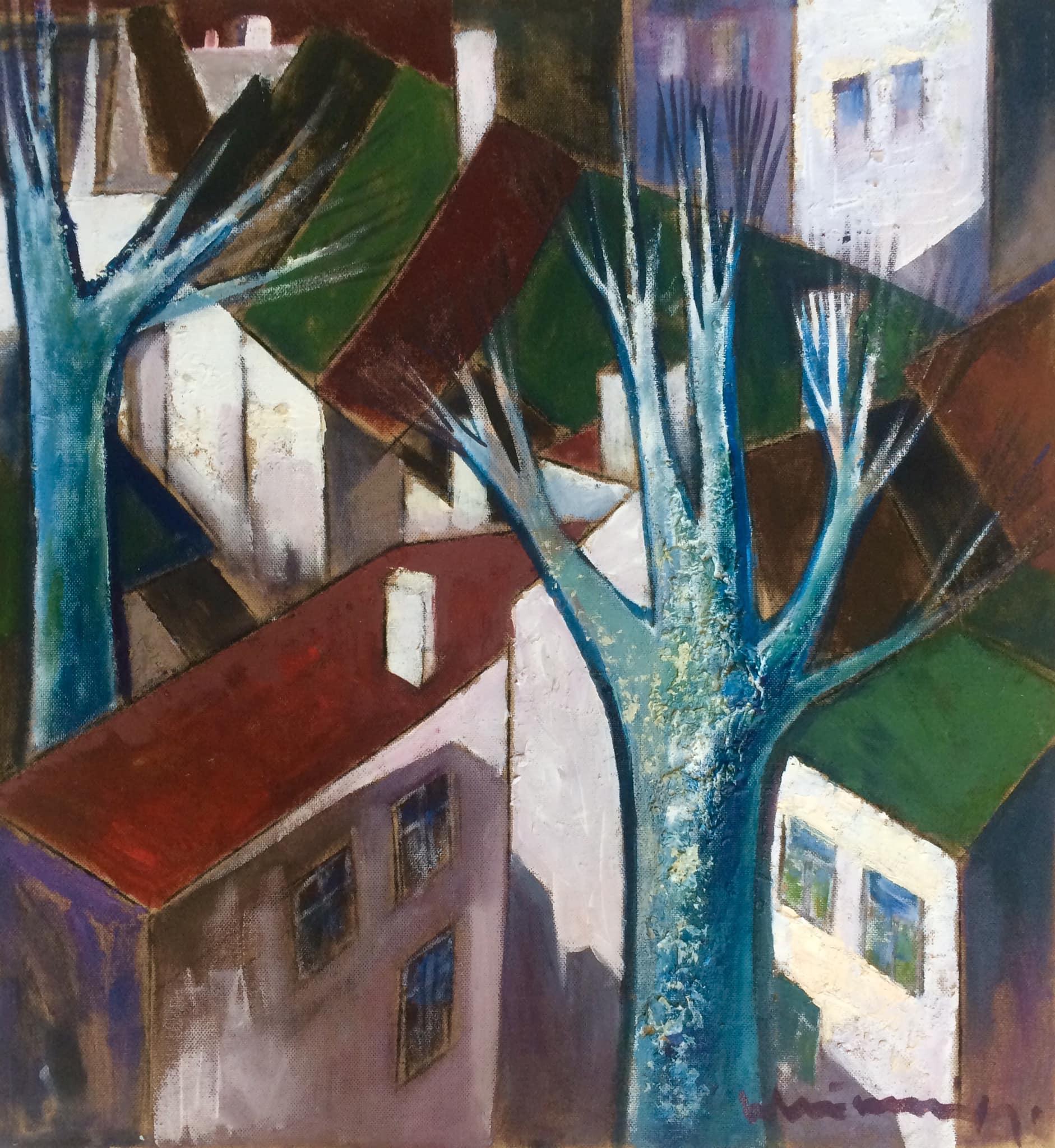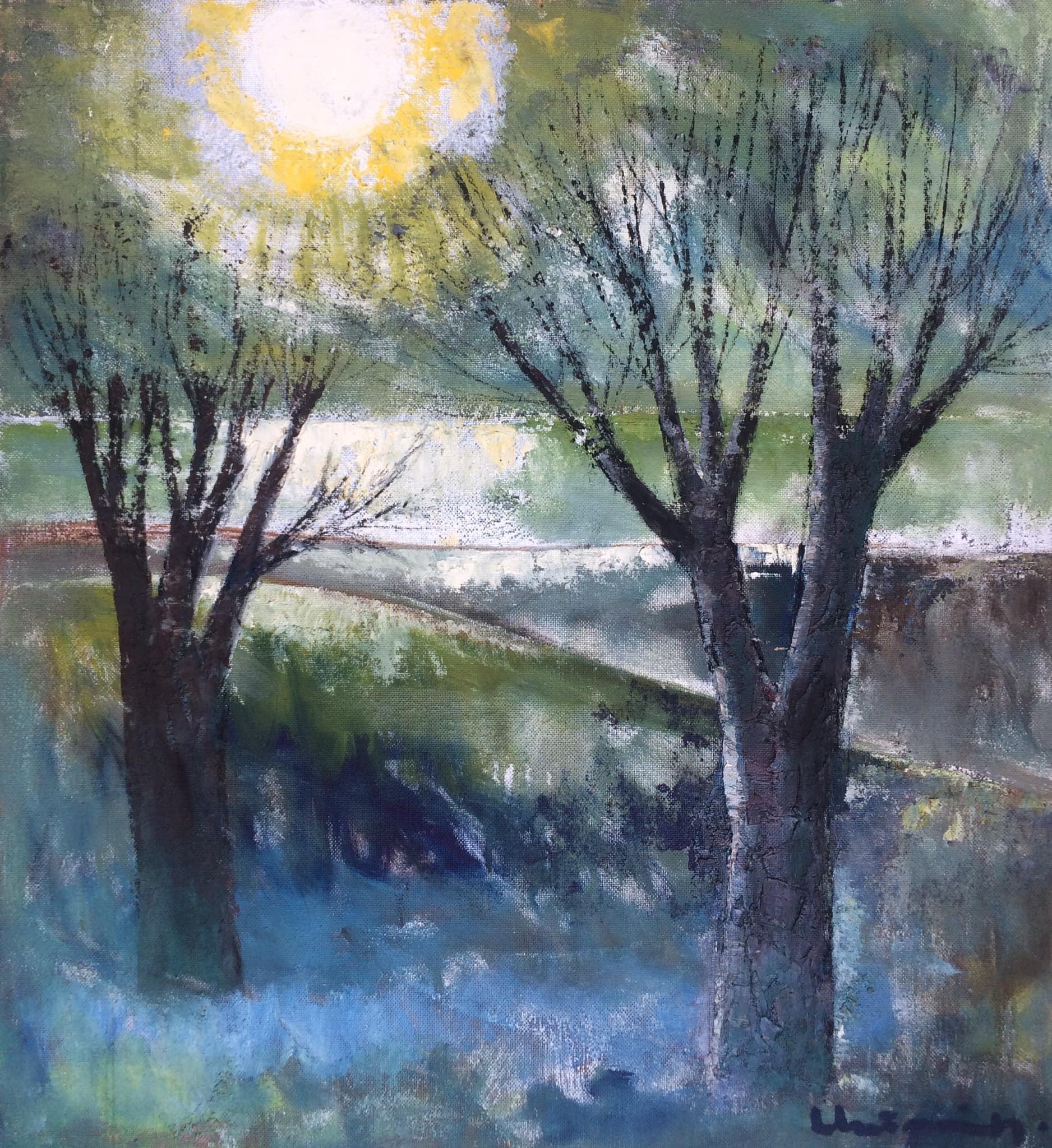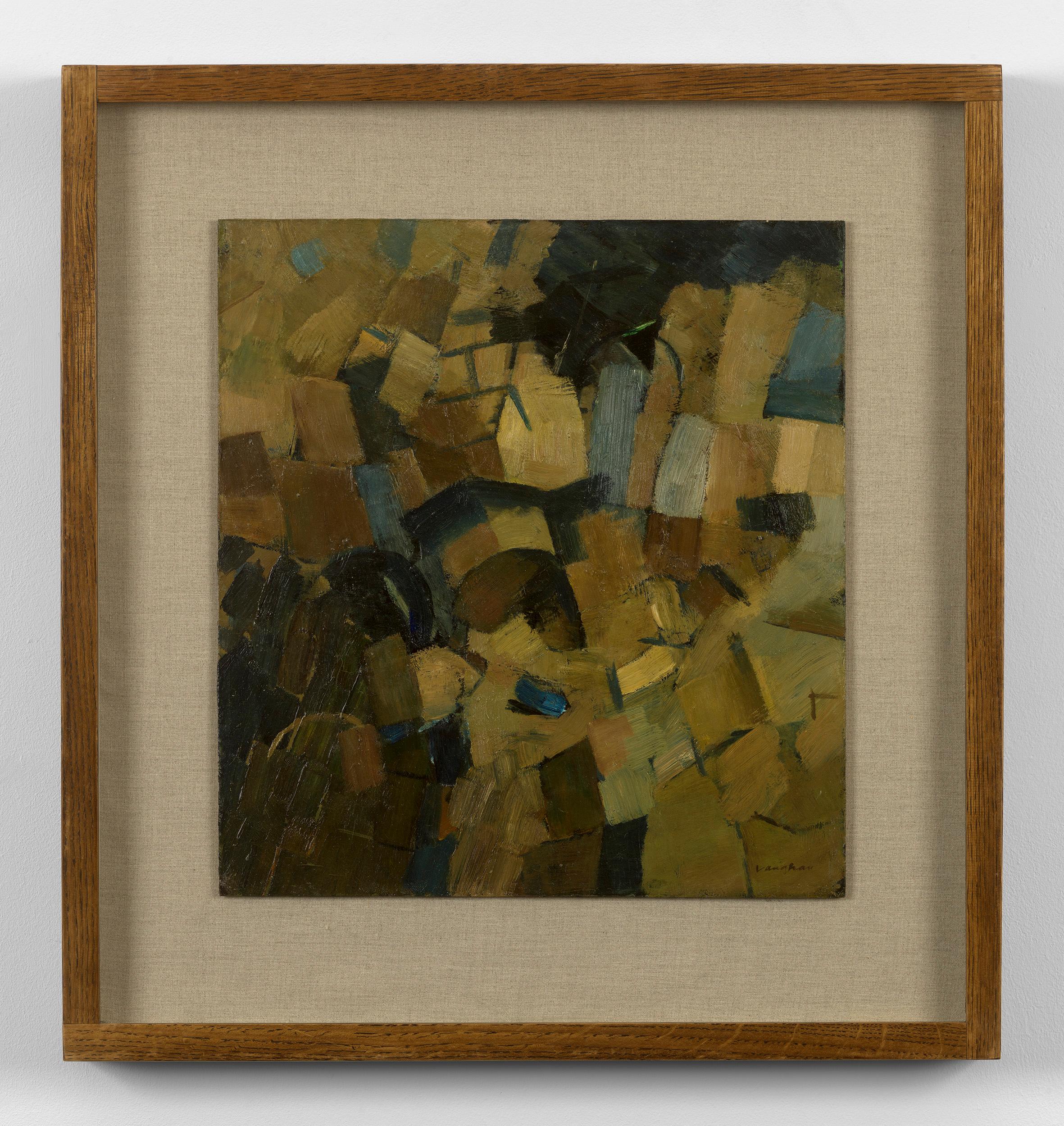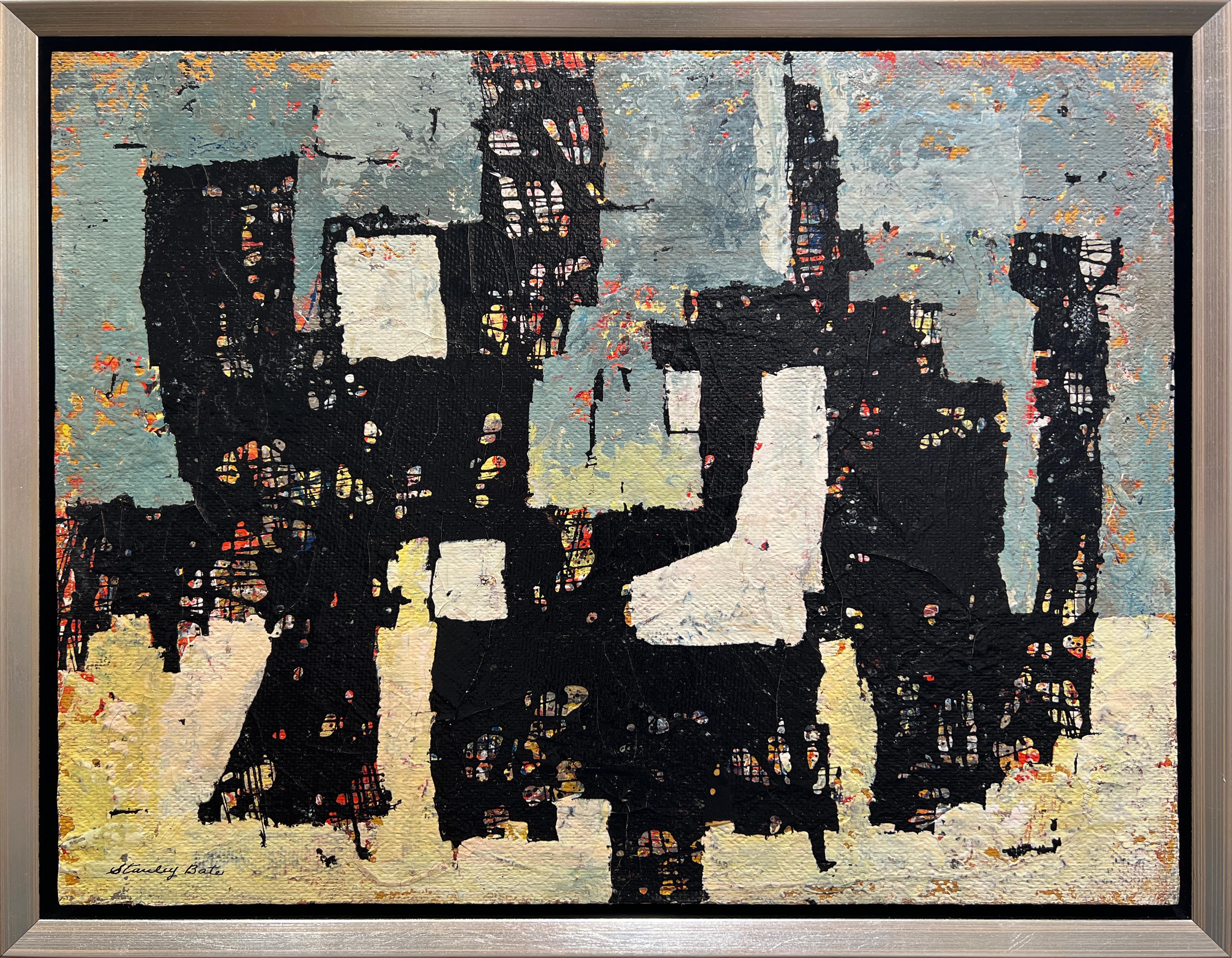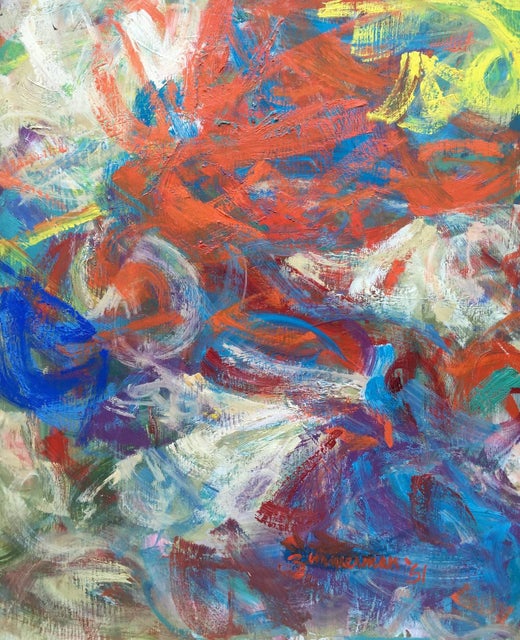Items Similar to "Untitled"
Want more images or videos?
Request additional images or videos from the seller
1 of 8
Sidney E. Zimmerman"Untitled"1961
1961
About the Item
Sidney E.Zimmerman
USA (1926-2007) studied at the Brooklyn a Museum of Art after returning from Europe during WWII. In 1950, he studied with Morris Kantor and Vaclav Vytlacil at the Art Students League in New York. He spent 1952-1954 in Mexico City, and 1954-1955 in Paris. He was a life time member of the American Society of Contemporary Artists.
This painting by Sidney Zimmerman was done in 1961 and is oil on wood panel. Framed in new floating gallery frame.
- Creator:Sidney E. Zimmerman (1926 - 2007, American)
- Creation Year:1961
- Dimensions:Height: 29.5 in (74.93 cm)Width: 24 in (60.96 cm)Depth: 0.25 in (6.35 mm)
- Medium:
- Movement & Style:
- Period:
- Condition:Good condition; gallery floating frame.
- Gallery Location:Southampton, NY
- Reference Number:1stDibs: LU141535263
Sidney E. Zimmerman
Sidney E. Zimmerman studied in Berlin during World War II and then at the School of the Brooklyn Museum of Art and the New York Art Students League under the influential Vaclav Vytlacil. He also spent time painting in Mexico City and Paris. Zimmerman exhibited in many group and one-man shows.
About the Seller
5.0
Platinum Seller
These expertly vetted sellers are 1stDibs' most experienced sellers and are rated highest by our customers.
Established in 1977
1stDibs seller since 2013
476 sales on 1stDibs
Typical response time: <1 hour
- ShippingRetrieving quote...Ships From: Southampton, NY
- Return PolicyA return for this item may be initiated within 7 days of delivery.
More From This SellerView All
- “Abstract Sailing, 1945”By Nahum TschacbasovLocated in Southampton, NYOil on academy board by the Russian/American artist Nahum Tschacbasov. Signed and dated lower left, 1945. Condition: Excellent. Presently not framed. Biography : Russian-America...Category
1940s Modern Abstract Paintings
MaterialsOil, Fiberboard
- “Abstract Faces”By Louis WolchonokLocated in Southampton, NYOriginal oil painting on thick fiberboard by the well know American artist Louis Wolchonok. Circa 1960. An abstract with hidden faces in an out of focus dreamlike technique. Condit...Category
1960s Post-Modern Abstract Paintings
MaterialsOil, Fiberboard
- “Untitled Abstract”By Martin RosenthalLocated in Southampton, NYOriginal abstract oil painting on heavy card stock by the American artist Martin Rosenthal. Signed lower left and dated 1960. Condition is very good. Slight bow to board. Nicely pro...Category
1960s Abstract Expressionist Abstract Paintings
MaterialsOil, Board
- “Lightride”By Syd SolomonLocated in Southampton, NYHere for your consideration is a great example of the artwork of the well known American artist, Syd Solomon. Signed top left. Titled and dated verso 1978. The painting is oil and acrylic paint on mounted synthetic canvas. Condition is excellent. Overall framed measurements are 44.75 by 24.5 inches. Provenance: A Sarasota, Florida collector. SYD SOLOMON BIOGRAPHY American 1917-2004 Written by Dr. Lisa Peters/Berry Campbell Gallery “Here, in simple English, is what Syd Solomon does: He meditates. He connects his hand and paintbrush to the deeper, quieter, more mysterious parts of his mind- and he paints pictures of what he sees and feels down there.” --Kurt Vonnegut Jr. from Palm Sunday, 1981 Syd Solomon was born near Uniontown, Pennsylvania, in 1917. He began painting in high school in Wilkes-Barre, where he was also a star football player. After high school, he worked in advertising and took classes at the Art Institute of Chicago. Before the attack on Pearl Harbor, he joined the war effort and was assigned to the First Camouflage Battalion, the 924th Engineer Aviation Regiment of the US Army. He used his artistic skills to create camouflage instruction manuals utilized throughout the Army. He married Ann Francine Cohen in late 1941. Soon thereafter, in early 1942, the couple moved to Fort Ord in California where he was sent to camouflage the coast to protect it from possible aerial bombings. Sent overseas in 1943, Solomon did aerial reconnaissance over Holland. Solomon was sent to Normandy early in the invasion where his camouflage designs provided protective concealment for the transport of supplies for men who had broken through the enemy line. Solomon was considered one of the best camoufleurs in the Army, receiving among other commendations, five bronze stars. Solomon often remarked that his camouflage experience during World War II influenced his ideas about abstract art. At the end of the War, he attended the École des Beaux-Arts in Paris. Because Solomon suffered frostbite during the Battle of the Bulge, he could not live in cold climates, so he and Annie chose to settle in Sarasota, Florida, after the War. Sarasota was home to the John and Mable Ringling Museum of Art, and soon Solomon became friends with Arthur Everett “Chick” Austin, Jr., the museum’s first Director. In the late 1940s, Solomon experimented with new synthetic media, the precursors to acrylic paints provided to him by chemist Guy Pascal, who was developing them. Victor D’Amico, the first Director of Education for the Museum of Modern Art, recognized Solomon as the first artist to use acrylic paint. His early experimentation with this medium as well as other media put him at the forefront of technical innovations in his generation. He was also one of the first artists to use aerosol sprays and combined them with resists, an innovation influenced by his camouflage experience. Solomon’s work began to be acknowledged nationally in 1952. He was included in American Watercolors, Drawings and Prints at the Metropolitan Museum of Art, New York. From 1952–1962, Solomon’s work was discovered by the cognoscenti of the art world, including the Museum of Modern Art Curators, Dorothy C. Miller and Peter Selz, and the Whitney Museum of American Art’s Director, John I. H. Baur. He had his first solo show in New York at the Associated American Artists Gallery in 1955 with “Chick” Austin, Jr. writing the essay for the exhibition. In the summer of 1955, the Solomons visited East Hampton, New York, for the first time at the invitation of fellow artist David Budd...Category
1970s Abstract Expressionist Abstract Paintings
MaterialsCanvas, Oil, Acrylic, Board
- “Dune Watch”By Syd SolomonLocated in Southampton, NYHere for your consideration is a very well executed early abstract painting by the well known American artist, Syd Solomon. Oil paint on birch ply panel. Signed middle bottom. Signed, titled and dated 1966 verso. The painting was done in East Hampton, New York where Syd Solomon spent his summers. Condition is excellent. Overall framed measurements are 26 by 31.5 inches. Provenance: A Sarasota, Florida collector. Syd Solomon was born near Uniontown, Pennsylvania, in 1917. He began painting in high school in Wilkes-Barre, where he was also a star football player. After high school, he worked in advertising and took classes at the Art Institute of Chicago. Before the attack on Pearl Harbor, he joined the war effort and was assigned to the First Camouflage Battalion, the 924th Engineer Aviation Regiment of the US Army. He used his artistic skills to create camouflage instruction manuals utilized throughout the Army. He married Ann Francine Cohen in late 1941. Soon thereafter, in early 1942, the couple moved to Fort Ord in California where he was sent to camouflage the coast to protect it from possible aerial bombings. Sent overseas in 1943, Solomon did aerial reconnaissance over Holland. Solomon was sent to Normandy early in the invasion where his camouflage designs provided protective concealment for the transport of supplies for men who had broken through the enemy line. Solomon was considered one of the best camoufleurs in the Army, receiving among other commendations, five bronze stars. Solomon often remarked that his camouflage experience during World War II influenced his ideas about abstract art. At the end of the War, he attended the École des Beaux-Arts in Paris. Because Solomon suffered frostbite during the Battle of the Bulge, he could not live in cold climates, so he and Annie chose to settle in Sarasota, Florida, after the War. Sarasota was home to the John and Mable Ringling Museum of Art, and soon Solomon became friends with Arthur Everett “Chick” Austin, Jr., the museum’s first Director. In the late 1940s, Solomon experimented with new synthetic media, the precursors to acrylic paints provided to him by chemist Guy Pascal, who was developing them. Victor D’Amico, the first Director of Education for the Museum of Modern Art, recognized Solomon as the first artist to use acrylic paint. His early experimentation with this medium as well as other media put him at the forefront of technical innovations in his generation. He was also one of the first artists to use aerosol sprays and combined them with resists, an innovation influenced by his camouflage experience. Solomon’s work began to be acknowledged nationally in 1952. He was included in American Watercolors, Drawings and Prints at the Metropolitan Museum of Art, New York. From 1952–1962, Solomon’s work was discovered by the cognoscenti of the art world, including the Museum of Modern Art Curators, Dorothy C. Miller and Peter Selz, and the Whitney Museum of American Art’s Director, John I. H. Baur. He had his first solo show in New York at the Associated American Artists Gallery in 1955 with “Chick” Austin, Jr. writing the essay for the exhibition. In the summer of 1955, the Solomons visited East Hampton, New York, for the first time at the invitation of fellow artist David Budd...Category
1960s Abstract Expressionist Abstract Paintings
MaterialsOil, Board
- “Abstract”Located in Southampton, NYVery unusual and boldly colored original oil on canvas abstract painting done by the Russian artist Gufor Malyanov. Signed in cyrillic verso, dated 1952 and titled in cyrillic “Abst...Category
1950s Modern Abstract Paintings
MaterialsCanvas, Oil
You May Also Like
- Moth Barn Interior 3 - 20th Century, Oil on board by Alan ReynoldsBy Alan ReynoldsLocated in London, GBOil on board, signed verso. Reynolds made numerous paintings on the theme of ‘moth barn’, in addition to a lithograph dating from 1956. Moth Barn Interior 3 (1952) is a diminutive va...Category
1950s Modern Landscape Paintings
MaterialsOil, Board
- 1970s Abstract Figurative Framed Oil Painting, Modernist City Scene With CoupleLocated in Denver, CO1950s oil on board painting by George Cecil Carter portraying a modernist couple, thought to be Alfred Stieglitz & Georgia O'Keefe. Presented in a custom frame, outer dimensions measure 20 ⅝ x 13 ½ x 1 ⅞ inches. Image sight size is 16 ⅞ x 9 ⅞ inches. Painting is clean and in very good vintage condition - please contact us for a complete condition report. Provenance: Private Collection, Denver Colorado Expedited and international shipping is available - please contact us for a quote. About the Artist: George Cecil Carter was born in Oklahoma in 1908 and became a noted Colorado abstract expressionist alongside contemporaries including Al Wynne, Mary Chenoweth...Category
1950s American Modern Figurative Paintings
MaterialsOil, Board
- Roofs. 1991, oil on cardboard 91x85 cmLocated in Riga, LVLaimdots Murnieks had a significant influence on the development of Latvian painting at the end of the 20th century. His work 'Holiday' conveys the feeling lightness and joy, which i...Category
1990s Modern Landscape Paintings
MaterialsOil, Cardboard
- After the rain. 1991, oil on cardboard, 90x83 cmLocated in Riga, LVLaimdots Murnieks had a significant influence on the development of Latvian painting at the end of the 20th century. His work 'Holiday' conveys the fee...Category
1990s Modern Landscape Paintings
MaterialsOil, Cardboard
- Landscape - 20th Century, Oil on board by Keith VaughanBy Keith VaughanLocated in London, GBSigned lower right. From the later 1950s, Vaughan painted landscapes without figures that verged towards complete abstraction: works in which colour is tessellated into compositions ...Category
1960s Modern Landscape Paintings
MaterialsOil, Board
- "Abandoned Village, " 1960s Modern Abstract PaintingBy Stanley BateLocated in Westport, CTThis Modern Abstract Expressionist painting by Stanley Bate is made with oil paint and and lacquer on board. It features light textured and a light blue-grey and yellow palette contrasted by the almost black focal point of the composition. The painting is 14.5" x 19" and measures 16.25" x 20.5" x 2" framed. Signed by the artist in the lower left-hand corner of the painting, it is framed in a floater frame with warm silver face and black sides and is ready to hang. Stanley Bate was born on March 26, 1903 in Nashville, Tennessee. The Bates were an established Tennessee family, in fact, Henry’s brother William Bate was the governor of Tennessee from 1883-1887 and a United States Senator from 1887-1905. Stanley studied art at the Watkins Institute in Nashville. In the 1920’s Bate moved to New York City to study at the Art Students League under Frederick Bridgman. He soon landed a job with Encyclopedia Britannica, and from 1927-1929 served as art editor. From 1929 until his death in 1972, Stanley was a self-employed artist. He taught art classes at both the Art Students League and the Albany Institute of History and Art and brought in extra income by making illustrations for magazines such as “Outdoor Life” and “Popular Science”. On January 27, 1934 Stanley married Emilie Rossel. Emilie had emigrated from Switzerland to New York in 1923. She found work as a governess to Alfred Vanderbilt and later as an executive secretary for Wall Street investment brokers Kahn, Loeb and Co. Emilie met Stanley in New York in the early 1930’s when she attended one of his art exhibitions with a friend. The couple, who had no children, lived on 34th Street in Manhattan. During this period, Bate was producing and exhibiting his art and joined several artists groups. Stanley and Emilie became part of the New York art scene, dining weekly at the Society of Illustrators Clubhouse. Stanley Bate’s time in New York was pivotal in the formation of his painting style. He lived in New York during the inception of one of the most important Modern Art movements, one that helped New York replace Paris as the center of avant-garde art. This movement, which was called the New York School of artists, was later known as Abstract Expressionism. It was comprised of a loosely associated group of vanguard artists working in New York City during the 1940s and 1950s. The New York School was not defined by a specific style, but instead reflected a fusion of European Modernism and American social relevancy that was depicted in many individual styles. Influences of Surrealism, Cubism, and Modernism can be found in their work, along with an interest in experimenting with non-traditional materials and methods. American art was in the forefront of international avant-garde for the first time. Stanley Bate was undoubtedly exposed to the varied styles and techniques that were emerging during the formative years of the New York School. Mark Rothko and Robert Motherwell were formulating their versions of color field paintings. Joseph Cornell was experimenting with assemblages, collage and the use of different types of textured paints. Jackson Pollock was adhering objects such as buttons and coins into his early works, while Louise Nevelson was using found objects. Helen Frankenthaler added sand to her early paintings. The New York School artists were undermining traditional fine art by using mixed media and non-traditional methods. Stanley Bate absorbed these varied influences and soon his early realistic landscapes and still-lifes were replaced with something entirely new. The influence of Cubism, notably the flat shallow space of the picture plane, is obvious in many of Bate’s paintings. Surrealism is evident in Bate’s use of subjects from myth, primitive art and antiquity, along with the Automatism-like line work in his more linear images. The unfettered experimentation of the New York School is everywhere in Stanley Bate’s work. We see nods to color field, collage, the mixing of textures into paint, mixed media, the inclusion of found objects and thick, luscious impasto. Bate was prolific and experimented in various media including oil, watercolor, lithography, silk screen, wood cut, drawing, collage, ceramics and sculpture. Bate is considered a true Modernist. His work is largely abstract, but sometimes figures and buildings are discernable. He frequently mixed paint, sand and glue together to achieve a textured surface, and then scraped and scratched through this layer to expose some of the underpainting below. His sculpture, which is often whimsical, also reflects the non-traditional methods of the New York School. Bate pioneered the use of enamel and copper in his work. The sculptures are not carved or modeled as was done in the past, but instead are built using mixed media and new materials. In addition to the New York School influence, many of Bate’s works exhibit a strong connection to the Spanish school, especially the work of Antonio Tapies and Modesto Cuixart. These artists were both part of an avant-garde group known as Art Informel, the Spanish equivalent of Abstract Expressionism. These artists likewise worked in mixed media and introduced objects and texture into their work. Many of Bate’s subjects and titles relate to Spanish locations and words. It is likely that Stanley spent time in Spain and found inspiration there. By the early 1940s, Stanley and Emilie had started spending weekends in a barn they purchased in Craryville, New York, a few hours north of Manhattan. The barn had no electricity or plumbing, but when the Bates eventually decided to leave New York and live full time in Craryville, they remodeled the barn, putting a gallery downstairs and a studio and living quarters upstairs. Although the Bates moved out of New York City, Stanley remained part of the New York art scene, exhibiting in New York and elsewhere throughout the 50s and 60s. During his lifetime he was represented by the New York galleries Knoedler and Company, Kennedy Galleries, Rose Fried Gallery and Key Gallery, along with Tyringham Gallery located in Tyringham, Massachusetts. Craryville was Stanley’s home until his death on August 21, 1972. Emilie died 1984...Category
1960s Modern Abstract Paintings
MaterialsLacquer, Oil, Board
Recently Viewed
View AllMore Ways To Browse
Japan Fox
Robert Wood Watercolor
Artist Hartley
Blue Grey And Green Abstract Paintings
Brown Betty
Dior Inclusion
Hans Harders
Jean Off White
Mosaics Rome Italy
Oval Painting Abstract
The Vortex
Vases With Lilacs
Denise Wood
Helen J
Japanese Zen Painting
Pafa Artists
Robert Motherwell Untitled
Russian Tables 19th Century
